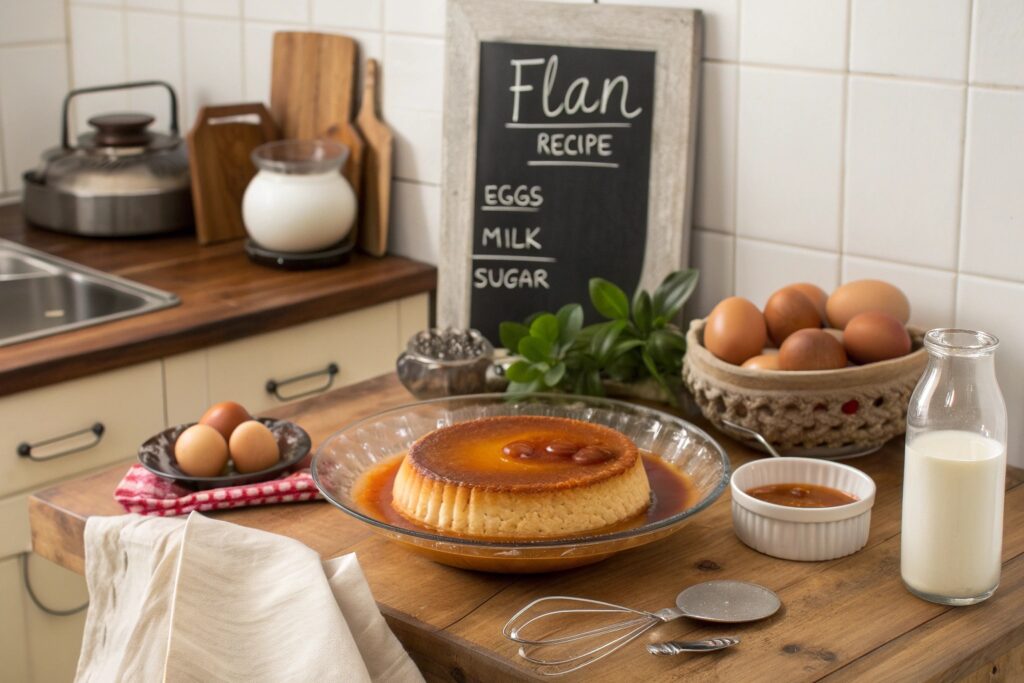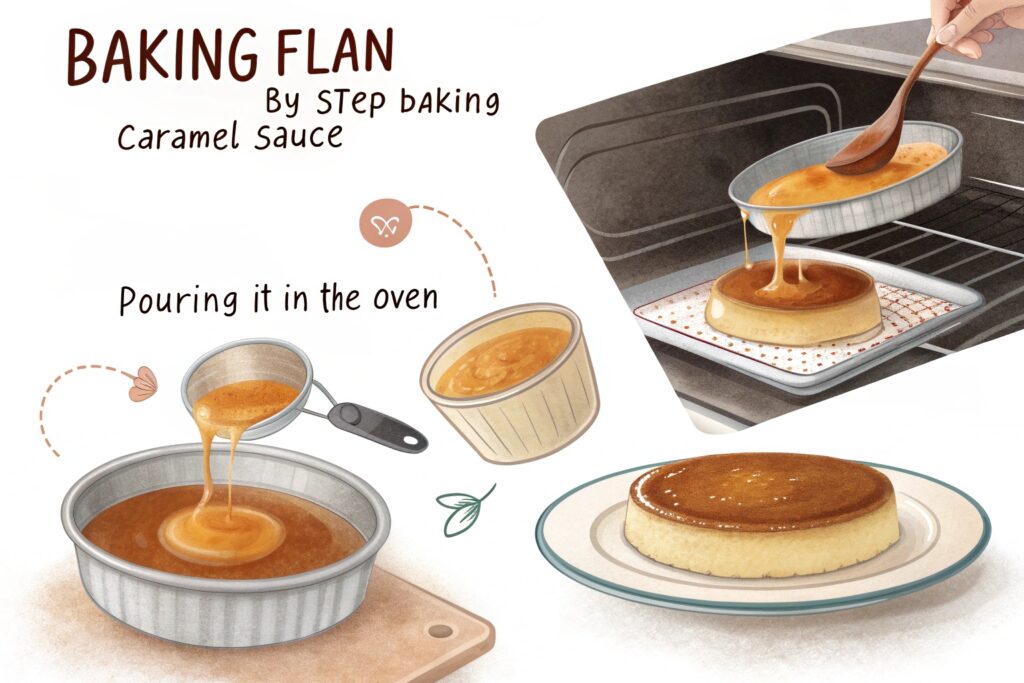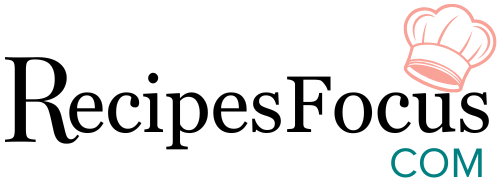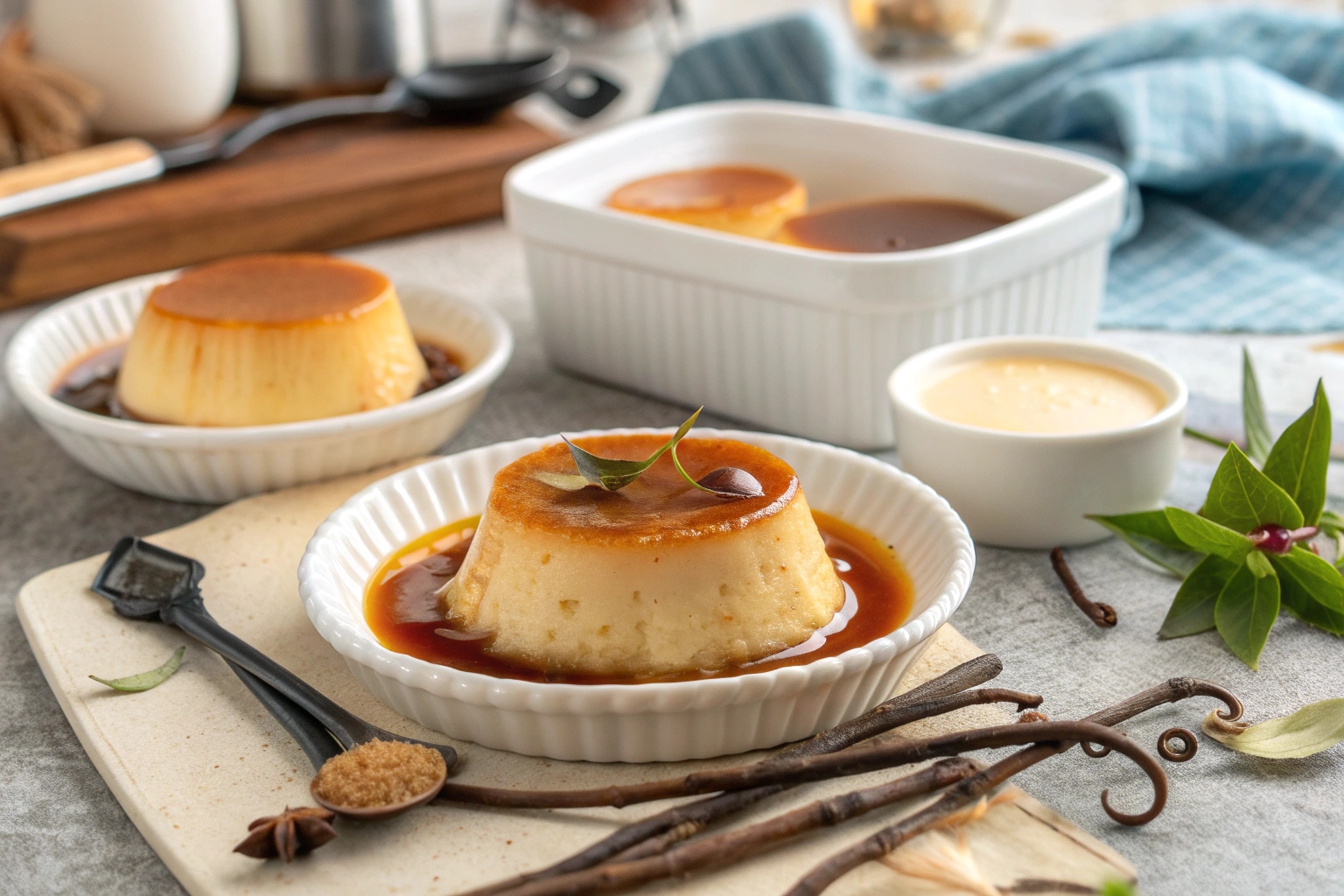Flan is one of the most beloved desserts worldwide, known for its smooth, creamy texture and rich caramel topping. This classic custard dessert has been cherished across cultures for centuries, particularly in Spain, Latin America, and the Philippines. Whether you’re making it for a special occasion, dinner parties, or simply indulging in a homemade treat, mastering the art of a flan recipe is easier than you think.
In this guide, you’ll learn everything about flan, from its origins and essential ingredients to the techniques that ensure a flawless, velvety texture. With detailed instructions, expert tips, and delicious variations, you’ll be able to create the perfect flan recipe every time. Let’s dive into the history, ingredients, and step-by-step process of making this decadent dessert.

Definition and Origins of Flan
Flan is a smooth and creamy custard dessert topped with a layer of caramelized sugar. Its origins can be traced back to the Roman Empire, where early versions were made using honey and eggs. As the recipe evolved, it became popular across Europe, Central America, and South America, with each region adding its own unique twist.
In Spain, flan is considered a staple dessert, often referred to as flan de huevo (egg flan). When the Spanish colonized the Americas, they introduced the dish to Mexico and other Latin American countries, where it quickly became a beloved treat. Today, there are numerous variations of flan, from Mexican flan to Filipino leche flan, each featuring distinct flavors and preparation techniques.
Essential Ingredients for Flan
A traditional flan recipe requires just a handful of simple ingredients, most of which are kitchen staples. Each component plays a crucial role in achieving the dessert’s signature silky texture and sweet caramelized flavor:
- Granulated sugar – Used to create the caramel topping, which provides a delightful contrast to the creamy custard.
- Condensed milk – Adds sweetness and a rich, velvety texture.
- Evaporated milk or regular milk – Contributes to the smooth consistency of the custard.
- Heavy cream – Enhances the creaminess and depth of flavor.
- Egg yolks – Act as the binding agent, giving the custard its structure.
- Vanilla extract or vanilla bean – Adds warmth and a fragrant aroma to the dessert.
- Cup granulated sugar – Essential for achieving a golden caramelized sugar syrup.
- Cans of milk – Typically, a combination of evaporated milk and condensed milk is used.
- Egg mixture – A well-whisked blend of whole eggs and extra yolks ensures the right consistency.
- Teaspoon vanilla extract or vanilla paste – Provides depth and enhances the overall flavor.
Variations for Dietary Preferences
Flan can be adapted to suit various dietary preferences and restrictions. Here are some popular variations:
- Dairy-Free Flan: Substitute coconut milk, almond milk, or oat milk for the dairy-based ingredients.
- Sugar-Free Flan: Replace granulated sugar with sugar alternatives such as erythritol or monk fruit sweetener.
- Vegan Flan: Replace eggs with a cornstarch slurry, silken tofu, or agar-agar as a setting agent.
Preparing the Caramel Layer
The caramelized sugar layer is what gives flan its distinctive look and taste. Follow these steps to create the perfect caramel topping:
- Melt granulated sugar in a medium saucepan over medium-low heat until it dissolves and turns a deep amber color.
- Swirl the pan gently to distribute the caramel evenly.
- Pour the caramel into a baking dish or individual ramekins, ensuring the bottom is fully coated before it hardens.
Making the Custard Mixture
The flan mixture must be prepared carefully to achieve the perfect smooth and creamy consistency:
- Whisk the egg yolks in a large mixing bowl until fully combined.
- Heat the milk mixture (evaporated milk, condensed milk, and heavy cream) in a medium saucepan over medium-low heat until warm (but not boiling).
- Slowly pour the warm milk mixture into the whisked eggs while stirring continuously to prevent curdling.
- Add the vanilla extract and whisk until well combined.
Step-by-Step Instructions for Baking Flan

Setting Up a Bain Marie
A bain marie (water bath) is essential for even cooking and preventing cracks in the custard:
- Place the flan mold in a deep roasting dish.
- Pour boiling water into the roasting dish until it reaches halfway up the mold, ensuring even heat distribution.
Baking Time and Temperature
- Preheat oven to 325°F (163°C).
- Bake for 45-50 minutes for small ramekins or 70-80 minutes for a large baking dish.
- The flan is done when the center is slightly jiggly but set.
Tips for Achieving the Perfect Flan
Preventing Cracks in the Custard
- Bake at a low, consistent temperature.
- Avoid overbaking, which can cause curdling.
- Use a kitchen towel in the bain marie for gentle heat distribution.
Ensuring Creaminess
- Strain the mixture through a fine mesh sieve to remove bubbles or egg solids.
- Allow the flan to cool completely before refrigerating.
Storage Options for Leftover Flan
- Refrigerate in an airtight container for up to 5 days.
- Freeze individual portions for a make-ahead dessert.
Frequently Asked Questions
How can I make flan less sweet?
Reduce the condensed milk and use a sugar alternative if desired.
Can I use alternative milks in flan?
Yes, almond, coconut, or oat milk can replace regular milk for a dairy-free option.
What is the best way to reheat flan?
Flan is best enjoyed cold, but to warm it slightly, place it in warm water for a few minutes.
Complementary Dessert Suggestions
- Fresh fruit like berries and mangoes.
- Classic Latin desserts like Tres Leches Cake.
- French Crème Caramel, a similar custard dessert.
Nutritional Information for Flan
Flan is rich in calcium and protein, but also high in sugar and fat. A moderate serving can fit into a balanced diet.
With this authentic flan recipe, you can create a smooth, creamy dessert that’s perfect for any occasion. Enjoy and impress your guests with this delicious homemade flan!
You can find more Dessert ideas in our desserts category.

